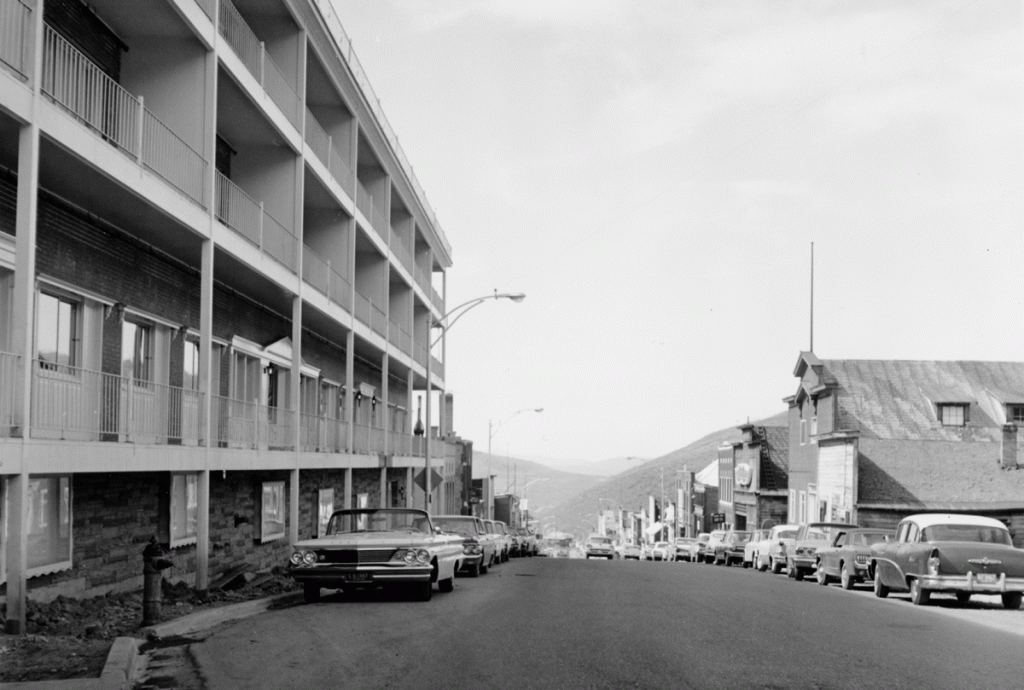Park City underwent significant economic and social changes in the 1960s as it started evolving from a declining mining town into the thriving city it is today. At the beginning of the decade, the town was in decline; Park City’s mining industry was slowing, with strong union activity and the decreasing value of important minerals frequently disrupting the remaining mines’ operations.[i] With the town’s growth being depressed by the shrinking local economy, residents from that time remember Main Street being “pretty empty,” with many of the windows boarded up.[ii] Looking back, however, some locals insist that Park City was not turning into a ghost town, as the town’s remaining inhabitants were proud of their community and had no desire to leave.[iii] Regardless, Park City was dwindling, as Parkites left as mines began to close.
In an effort to diversify its income, the main lingering mining company (United Park City Mines) founded the town’s first ski resort, Treasure Mountains (now PCMR), in 1963.[iv] The state backed the new resort, promoting Utah’s burgeoning ski industry and drawing more and more visitors to Park City.[v] A period of economic revitalization followed the resort’s establishment, as new people arrived in town and new businesses opened to service arriving tourists.[vi] The endeavor was so successful that one Parkite remarked the mining company should stick with the “gold on top of the mountain instead of the silver in it.”[vii]
Nineteen-sixty-five also saw the opening of Treasure Mountain Inn on Main Street, which dramatically transformed the center of town. One resident remembered it as the “only big building on Main Street” at the time of its construction, standing in sharp contrast to the run-down bars and stores that occupied it at the beginning of the decade.[viii] The evolution that the new ski resort and Treasure Mountain Inn represented, however, was not universally welcomed by Parkites. Though the Park Record described the Inn and its owners “already a true part of Park City,” some found the Inn and the new resort off-putting, symbols of a cultural transformation which longtime locals worried would leave no place for them.[ix]

Credit: Park City Historical Society & Museum
These concerns intensified as new arrivals drifted into the town to work at the resort or ski the slopes. Park City’s miners already felt outnumbered by the end of 1963, and they maintained a distinct community which did not meld with the new arrivals.[x] The two groups went to different bars and lived in different areas; the settled Parkites often derisively referred to the new, young residents as “hippies.” The newcomers collected in a neighborhood of makeshift houses underneath Deer Valley Drive at the base of Masonic Hill called “Easy Street” (one resident referred to it as “Sleazy Street,” reflecting prevailing opinions of the district).[xi] The transplants brought a new cultural scene to the town, establishing music venues and gradually incorporating themselves into Park City’s traditions.[xii] Ultimately, skiing culture prevailed in Park City, though many have worked and continue to work toward preserving Park City’s mining heritage.
The Park City Museum is hosting an in-person lecture on the 1960s called “Approaches to Black Freedom: Race, Gender, and Radicalism” given by Dr. Joseph Stuart on Wednesday, November 16th from 5-6 p.m. in their Education and Collections Center at 2079 Sidewinder Drive. Register here.
[i] “Strike Threats May Close Mine,” Park Record, August 20, 1959, 1, https://newspapers.lib.utah.edu/ark:/87278/s6j39w31/8084942; “Droubay Sees Good, Bad in Union: United Park Mines Report Losses,” Park Record, August 20, 1959, 1, https://newspapers.lib.utah.edu/ark:/87278/s6j39w31/8084952; David Chaplin, interview by Larry Warren, in Park City, Utah (Park City, UT: Park City Museum, 2022); Keith Droste, interview by Lola Beatlebrox on December 12, 2012, in Park City, Utah (Park City, UT: Park City Museum, 2022).
[ii] Chaplin, interview; Matt Alvarez, interview by Lola Beatlebrox on October 24, 2005, in Park City, Utah (Park City, UT: Park City Museum, 2022).
[iii] Mel Fletcher, interview, in Park City, Utah (Park City, UT: Park City Museum, 2022).
[iv] John Henry Auran, “Don’t Call It Park City; It’s Really Treasure Mountain,” Skiing, February 1967, 59;
[v] Susan Sessions Rugh, “Branding Utah: Industrial Tourism in the Postwar American West,” The Western Historical Quarterly 37, no. 3 (2006).
[vi] Alzarez, interview; Helen Blonquist, interview by Sandra Morrison and Navee Vernon on September 5, 2001, in Park City, Utah (Park City, UT: Park City Museum, 2022).
[vii] Blonquist, interview.
[viii] Alvarez, interview.
[ix] “New Treasure Mountain Inn Holds Grand Opening Feb. 21,” Park Record, February 18, 1965, 1, https://newspapers.lib.utah.edu/ark:/87278/s60p22j5/8090501; Tom Clyde, interviewed by Larry Warren, in Park City, Utah (Park City, UT: Park City Museum, 2022).
[x] Cylde, interview.
[xi] Ibid.
[xii] “Labor Day Celebration in Park City Pleases Crowd of Several Thousand,” Park Record, September 7, 1967, 1, https://newspapers.lib.utah.edu/ark:/87278/s6126w7p/8129509.